In this post, you will learn to deploy Pidgin using Intune EXE Deployment Guide. Let’s look at the steps to deploy Pidgin using Intune, we will use the EXE file to deploy on the Windows 10/11 client machines.
Pidgin is a language extension that uses simple grammar and vocabulary to communicate between two or more people who do not speak the same language. In this case, the pidgin language is a combination of several languages in which the vocabulary and grammar are restricted.
It is a chat program that allows you to log in to multiple chat networks simultaneously with a single account. Thus, it is possible to chat with friends on XMPP and participate in IRC channels at the same time. The Pidgin application runs on Windows, Linux, and other UNIX-like platforms.
Pidgin supports many features of these chat networks, including file transfers, away messages, buddy icons, custom smileys, and typing notifications. Additionally, Pidgin’s functionality can be extended beyond the standard features through various plugins.
All the details of the application are given below. The install and uninstall command line and the App install detection method are explained below. You can download Pidgin from the following link, Pidgin, the universal chat client.
- Install Google Earth Pro Using Intune Step-By-Step Guide
- Amazon Corretto Installation Using Intune MSI Application
Prepare Win32 App Installation Source for Pidgin
Preparing a Win32 app using the Microsoft Win32 Content Prep Tool is necessary before adding it to Microsoft Intune. To pre-process Windows classic (Win32) applications, you use the Microsoft Win32 Content Prep Tool.
Let’s first identify the command line to perform the silent installation or uninstallation of Windows Pidgin.
Silent Install Command Line for Pidgin
With the help of the internet, You can find an Install command for any application. In our case, we have to search the install command for the Pidgin Application. After searching, the install command for the Pidgin Application is pidgin-2.14.10-offline.exe /DS=0 /SMS=1 /L=1033 /S.
After you successfully install Pidgin using the install command in your test environment. Now you have to look for the Uninstall command. For this, the Uninstall Command for Pidgin is “%ProgramFiles(x86)%\Pidgin\pidgin-uninst.exe” /S.
| Install Command | Uninstall Command |
|---|---|
| pidgin-2.14.10-offline.exe /DS=0 /SMS=1 /L=1033 /S | “%ProgramFiles(x86)%\Pidgin\pidgin-uninst.exe” /S |
Download the updated IntuneWinAppUtil.exe from GitHub. Run IntuneWinAppUtil.exe file Run as administrator.
- Please specify the source folder – Enter the folder that contains your application setup files. (For Example, C:\Pidgin)
- Please specify the setup file – Enter the setup file name (such as setup.exe or setup.msi), for Example – pidgin-2.14.10-offline.exe
- Specify the output folder – Input the output folder to generate the .intunewin file.
- Do you want to specify catalog folder – Type N.
Note! Please wait a few minutes while running the Win32 Content Prep Tool. Once it generates the .intunewin file, the status indicates 100% at the bottom of the command prompt.

Once the process completes, Browse to the output folder (For Example, C:\Pidgin) to collect the Intune Win32 app deployment file.
Deploy Pidgin Using Intune EXE Deployment Guide
Let’s follow the steps below to upload the Intunewin file for deploying Pidgin to managed devices. Here’s how you can deploy Pidgin using Intune Portal.
- Sign in to the Microsoft Intune admin center https://endpoint.microsoft.com/ with appropriate access rights.
- Select Apps > All apps > Add, or navigate to Apps > Windows > Windows Apps.
- On the Select app type pane, select Windows app (Win32) under the Other app types and click Select.
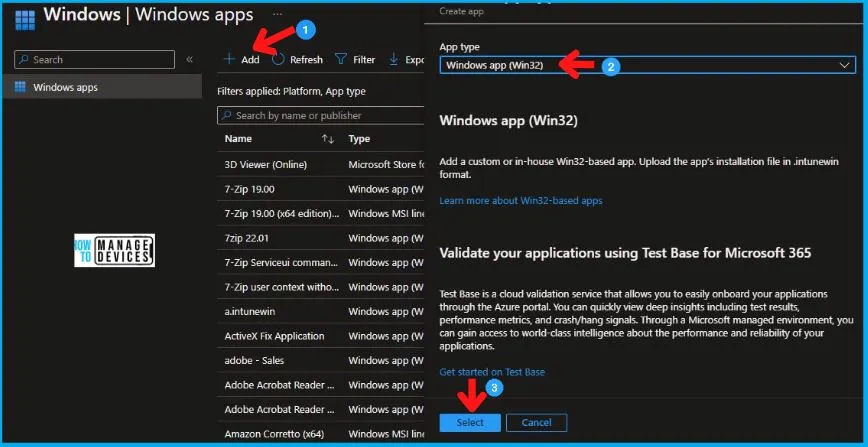
On the Add app pane, click Select app package file. Click the browse button. After that, select the prepared file with the extension .intunewin. Detailed information about the app appears. You can now select OK on the App package file pane when you’re done.
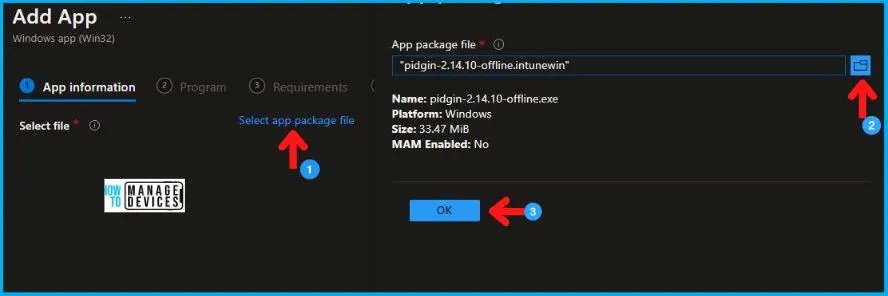
Enter the Name of the Windows App Win32 (For Example, Pidgin), and Enter the Description of the Windows App. Enter the Publisher name – Pidgin, and You may specify the additional app information here.
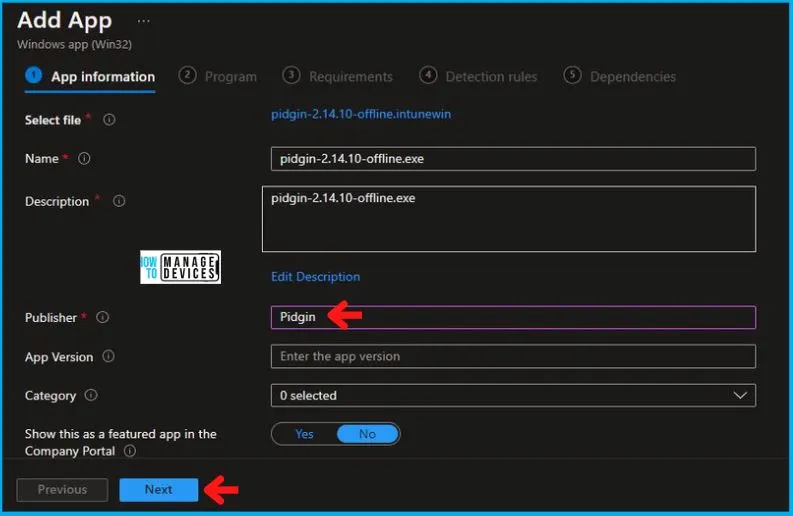
After entering the above details, you will get the option to Upload an icon for the app by scrolling down on the same page. This icon is displayed with the app when users browse the company portal and click Next.
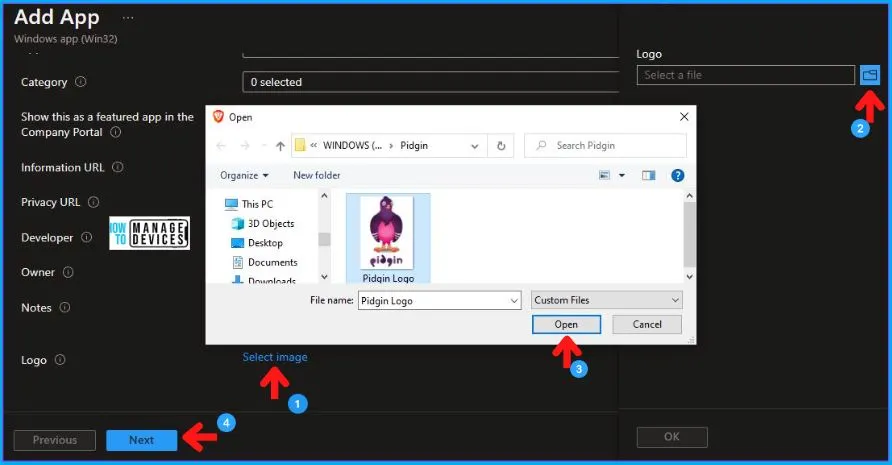
The most important part is to specify the commands. On the Program, configure the app installation and removal commands for the app:
- Install base: Add the complete installation command line to silent install Pidgin. (pidgin-2.14.10-offline.exe /DS=0 /SMS=1 /L=1033 /S )
- Uninstall command: Add the uninstallation command line for Pidgin. (“%ProgramFiles(x86)%\Pidgin\pidgin-uninst.exe” /S )
- Install behavior: Set the install behavior to System.
You can also specify the Device restart behavior and Post-installation behavior. Click Next to continue.
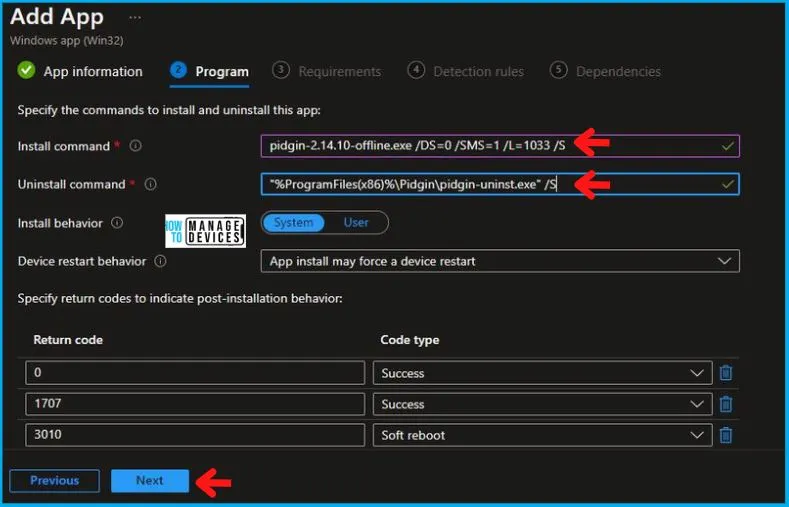
On the Requirements page, specify the mandatory requirements that devices must meet before installing the update and click Next.
- Operating system architecture: Choose the architectures needed to install Pidgin.
- Minimum operating system: Select the minimum operating system needed to install Pidgin.
There are some built-in and custom requirements rules when creating your Win32 application. Explore Intune Win32 App Requirement Rules.
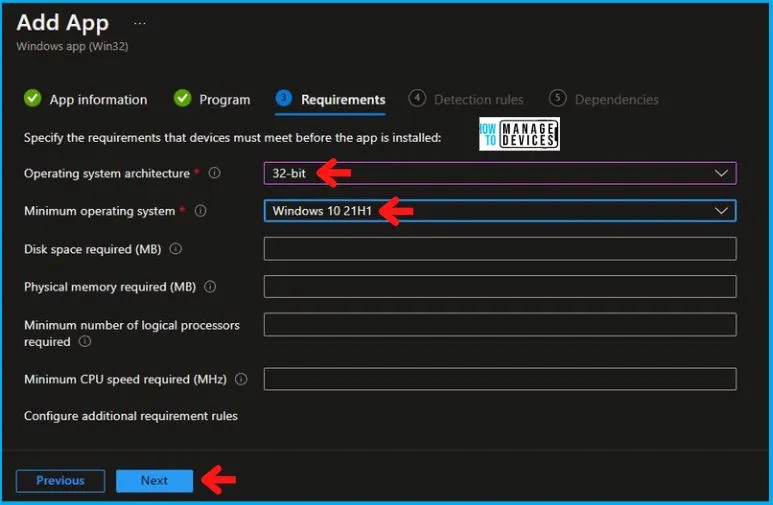
On the Detection rules pane, configure the rules to detect the presence of the app. You can choose to add multiple rules. Here I selected the Manually configure detection rules format. Click on Add button, and A popup will appear showing the Detection rule, select Registry.
Here you can check the registry path for the applications. Most apps are installed in the same location depending on the app architecture, and Detection Method for Intune Win32 App. For Example, Here, Check for registry value string equals.
After this, you have to check for the Detection Method. Here we try to use the Registry type for the detection method. For this, we need to go to Registry Editor, open the Find dialogue box, and search for Pidgin. The below path directly navigates you there.
Computer\HKEY_LOCAL_MACHINE\SOFTWARE\WOW6432Node\Microsoft\Windows\CurrentVersion\Uninstall\Pidgin
We double-click on the DisplayVersion and copied the Value data, DisplayVersion = 2.14.10.
| Setting Type | Hive | Key | Value | Data Type |
|---|---|---|---|---|
| Registry | Computer\HKEY_LOCAL_MACHINE | SOFTWARE\WOW6432Node\Microsoft\Windows\CurrentVersion\Uninstall\Pidgin | DisplayVersion | Version |
Check the details from the above table and enter as shown below carefully.
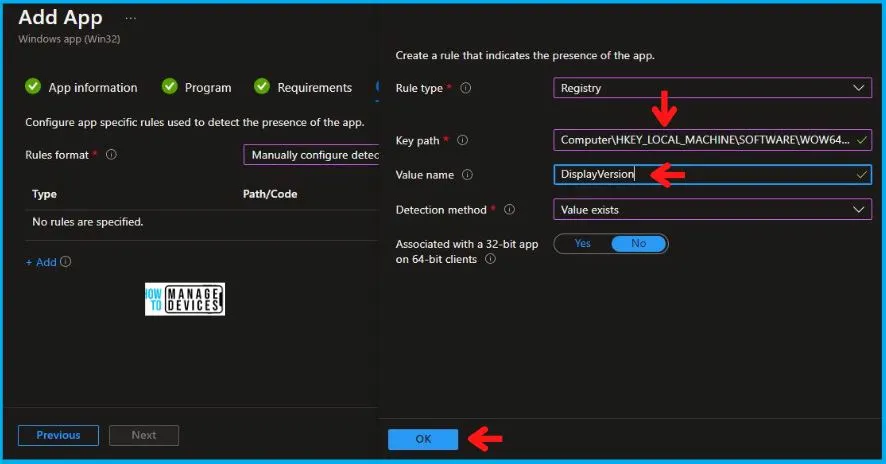
You can also specify app dependencies where the applications must be installed before your Win32 app can be installed. Also, in the scope tag section, you shall get an option to Configure scope tags for this Windows App Win32 application.
Under Assignments, In Included groups, click Add groups and then choose Select groups to include one or more groups to which you want to deploy the Windows Update. Click Next to continue.
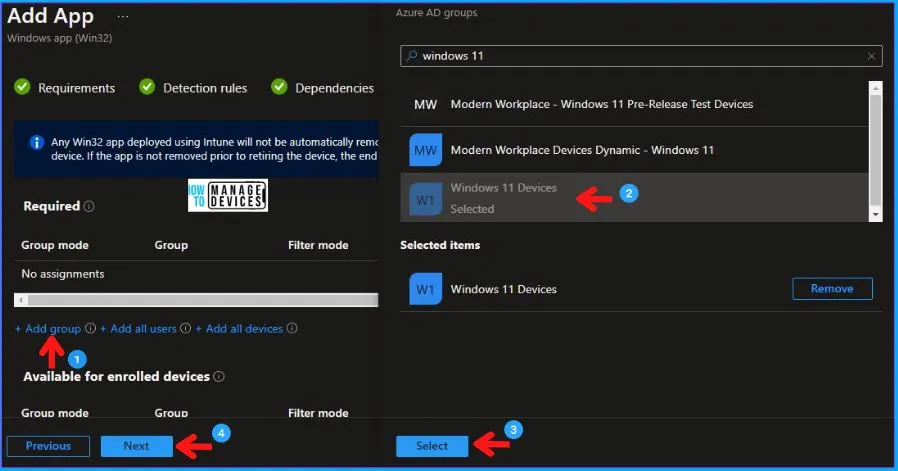
Now you will see all the details you provided during the application creation process. Review your settings and select Create to add the app to Intune.
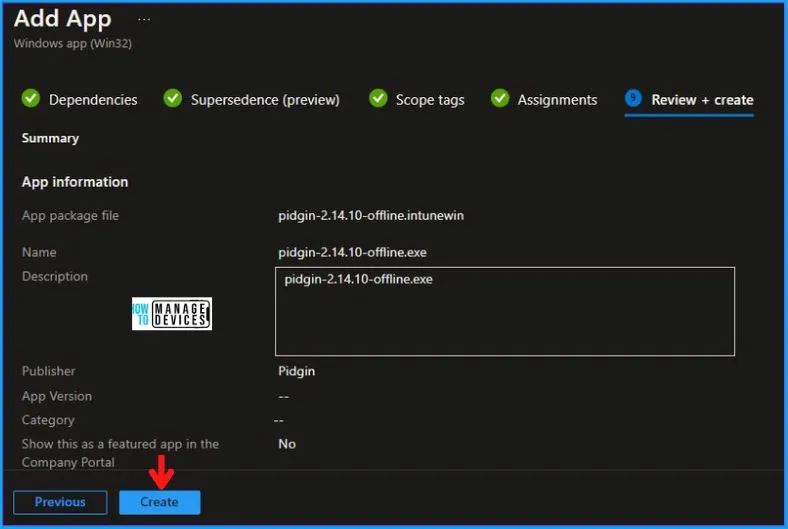
Once you proceed to create, you will see the status Uploading is in progress, If you are thinking about how much time will it take to complete the upload? It depends on the size of the application and the speed of internet connectivity.
Please wait some time to complete the upload process, and you can check the progress by clicking on the Notification icon. Once the intune package is uploaded and finished, you will get the status “Upload finished.”
- Intune Company Portal App for Windows 11 Android | Install and Uninstall
- 32 Privacy Settings for Windows 11 | 99 Intune Privacy Settings Policies
Intune Company Portal End Users Experience
Intune will deliver targeted applications to your groups when the devices check in with the service that applies to them.
On the client machine, In the Company Portal, You can click on the apps to track the details and check the progress. Here you can see the Pidgin application is installed successfully.
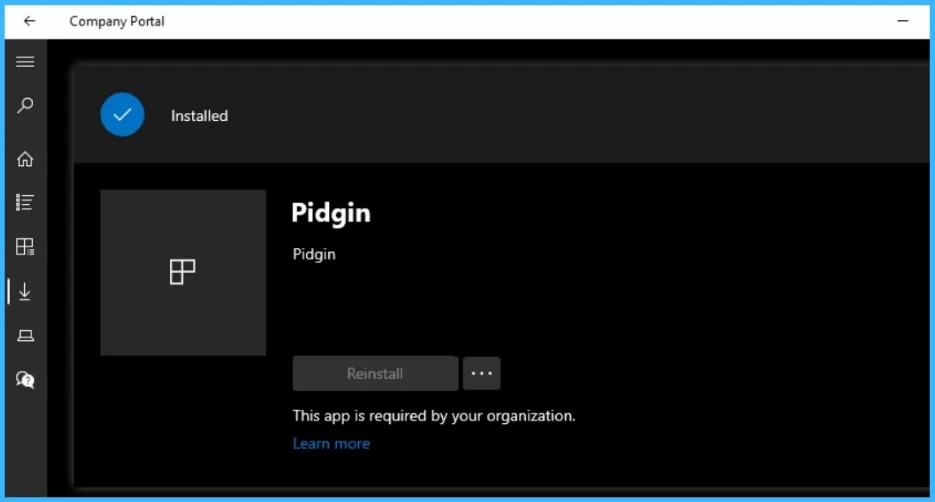
To monitor the application installation from Intune Portal, select the application, and here you can check the device and user check-in status. If you click on Device install status, additional details are displayed.
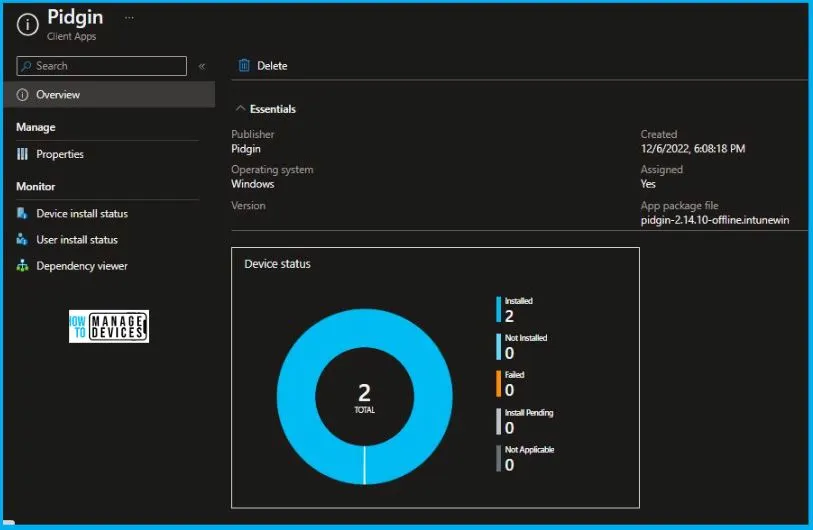
Monitor Pidgin Deployment
Once the application installation starts, the “Detection rule” will be evaluated. Checks were performed against the rules configured and the app “Install command” will be triggered.
You can track the details logged at IntuneManagementExtension.log located C:\ProgramData\Microsoft\IntuneManagementExtension\Log. You track the application activity in client devices. You can get through an excellent article on Intune Win32 App Issues Troubleshooting for more details.
Where is the folder where Intune downloads the applications before it installs on a Windows device? Intune cache folder location, Below are the 3 Intune Management Extension Agent working folders.
- Incoming
- Staging
- Staged
Let’s learn Intune Win32 App Troubleshooting Client-Side Process Flow. You can look at the Level 3 deep dive troubleshooting Intune Management Extension (IME) Level 3 Troubleshooting Guide.
Author
Abhinav Rana is working as an SCCM Admin. He loves to help the community by sharing his knowledge. He is a B.Tech graduate in Information Technology.
